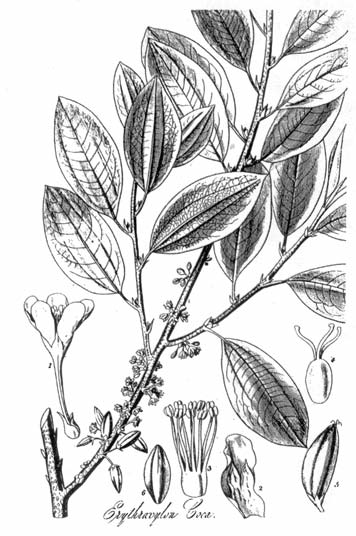
This Article From Issue
November-December 1998
Volume 86, Number 6
DOI: 10.1511/1998.43.0
A Brief History of Cocaine. Steven B. Karch. 202 pp. CRC Press, 1998. $19.95, paper.
The fascinating and relevant history of cocaine reaches back long before the 1970s, but the information has been so scattered or fragmentary that it has been difficult to comprehend. Steven Karch does not claim that his book is the definitive history of cocaine, but it is now the best volume on the topic. The author, an expert on the pathology of drug use and assistant medical examiner for the city of San Francisco, spent years researching this book as an avocation.

From A Brief History of Cocaine.
Karch's historical journey began when, almost by accident, he came upon Hans Maier's Der Kokainismus (1926), which described microscopic scarring of the heart after repeated cocaine use, a finding Karch had reported as a discovery in 1986 in the journal Human Pathology. He became fascinated with what could be called the first cocaine epidemic, almost forgotten and yet so similar to the one we are now experiencing.
Karch describes the coca bush's role in the Andes and the rise of coca-containing consumables such as Vin Martani, a Bordeaux wine with extract of coca leaves that was quite popular as a tonic in the late 19th century. In 1860 a graduate student, Albert Niemann, isolated and named cocaine. The Merck Company began to manufacture it, but the annual amount was about a quarter-pound and it was very expensive. Coca leaves did not travel well across the distance from South America to Europe, and so by the 1880s, when demand rose rapidly, processing plants in South America produced crude cocaine that held its potency until it could be purified.
Karch is particularly good at explaining the practical problems associated with selling cocaine, the marketing styles of the great pharmaceutical houses, especially Merck and Parke, Davis & Co., and the rise of Java as the major international supplier. Sigmund Freud was so impressed by his own experimentation with cocaine that he advocated it for many problems, even for curing the alcohol and morphine habits. Karch explains that Freud had been largely inspired (and misled) by articles he read in the Detroit Therapeutic Gazette, which was actually a house organ of Parke, Davis & Co. owned by George S. Davis.
Karch believes that by about 1912 the cocaine problem exceeded what we are now experiencing, a conclusion I hesitate to endorse. Even, however, if use then was just half of today's, it raises an important question: How could all that experience be forgotten? The first epidemic also presents us with a puzzle: How did it fade away? Although he offers no comprehensive answer to these questions, Karch does present intriguing evidence such as a gap—from 1914 to 1981—in reports of what he has come to see as a characteristic pathology of extensive cocaine use: agitated delirium.
Some of Karch's interests divert him from the topic. He goes into great detail about the Japanese manufacture and sale of opiates in areas they conquered on the Asian mainland. He draws on recently released intercepted messages deciphered by American code-breakers and on substantial records of the war-crimes trials in Tokyo following World War II. Some of the material relates to cocaine, but most is taken up with opiates. After giving strong evidence that Japan evaded international treaties in manufacture and distribution of these drugs, he absolves Japan of trying to "weaken the native inhabitants" (an accusation of the Allies) because he didn't find any statement to this effect in the documents, and he concludes that the expense of soldiery stationed in China motivated Japan to sell drugs to the Chinese.
Karch is not fully reliable on the details of treaties and legislation. The Harrison Act (1914), for example, did permit the prescribing of narcotics to treat addiction. What was prohibited, in most cases, was indefinite maintenance. He is surprisingly harsh in his criticism of Harvey Washington Wiley, the "father" of the Pure Food Act (1906). Overall, however, this is an excellent book that brings to light most of the salient issues of the coca/cocaine history. Much work remains to be done, but Karch has delivered what he set out to create: a convenient, scholarly and well-written outline of cocaine's history.—David F. Musto, Psychiatry, Yale University
American Scientist Comments and Discussion
To discuss our articles or comment on them, please share them and tag American Scientist on social media platforms. Here are links to our profiles on Twitter, Facebook, and LinkedIn.
If we re-share your post, we will moderate comments/discussion following our comments policy.